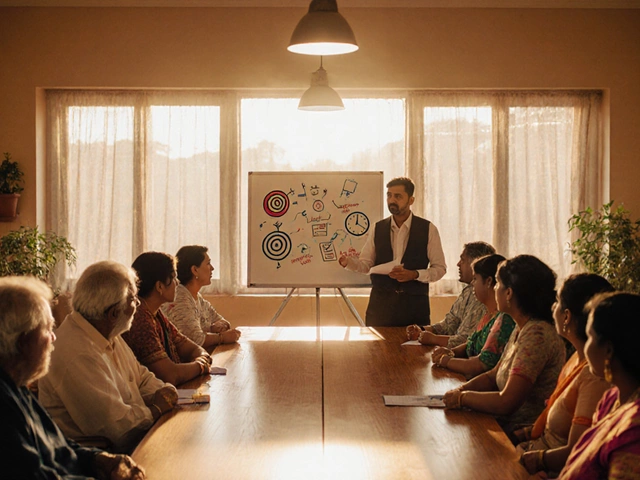Charity events have become pivotal in bridging the gap between generosity and need. Their significance isn't just in the amount of money they raise but in the awareness and support they garner for noble causes. When people come together with a shared purpose, the outcomes can be surprisingly impactful.
These events are the heartbeats of philanthropy, offering a platform for both local and global issues. They connect people in meaningful ways, enabling them to become a part of something greater than themselves. This article delves into the fundamental goals of charity events and explores how they not only change how communities respond to causes but also enrich the fabric of society by creating lasting impacts.
- The Core Objectives of Charity Events
- Effective Strategies for Successful Events
- Community Building and Social Impact
- Engaging Donors and Stakeholders
The Core Objectives of Charity Events
Charity events serve as a crucial mechanism for generating funds, yet their reach and ambition often stretch beyond simple monetary gain. At the heart of these gatherings lies the primary goal of fundraising, a necessity that underpins the aspirations of countless nonprofit organizations. This objective encourages active participation from various quarters, be they individual donors, local businesses, or global corporations. By organizing these events, charities can directly channel resources towards initiatives that combat health issues, address education disparities, aid disaster relief efforts, or support environmental sustainability. The financial outcomes are no doubt vital, yet the method of tapping into the potential of charity events often requires ingenuity and strategic planning.
Another significant objective is raising awareness about the cause at hand. Charity events are a powerful tool for enlightening both participants and the larger public about specific issues that demand attention. Through themes, speeches, and activities, these occasions underscore the importance of the charity's mission, helping to sculpt attitudes and alter perceptions in the broader community. It's about planting seeds of awareness that may blossom into future action. On one such occasion, a prominent philanthropist noted,
"Awareness is the first step towards any meaningful change. A community enlightened is a community empowered."This underscores how charity events can mobilize and empower people to advocate for change in various facets of society.
Building a sense of community and fostering social connections remains another core aim. Charity events are scenes of collaboration, bringing together people from different walks of life united by a common purpose. This gathering acts as a catalyst for networking and community engagement, which can forge bonds that extend long after the event itself. The shared experience of working toward a philanthropic goal helps cultivate a culture of giving and encourages continuous volunteerism among the participants. At these events, individuals find kinship in charity, often resulting in strengthened community ties and a renewed social commitment to tackle shared challenges.
Moreover, charity events offer a unique avenue for innovation and creativity. Planning and executing such events cultivate an environment where creativity is not just welcomed but celebrated. Teams are often challenged to come up with novel ideas to engage attendees, which can range from integrating technology into the event to creating interactive experiences that deeply connect participants with the cause. This creative energy often results in more compelling and effective messaging, enhancing the impact and outreach of the event. The diversity of ideas nurtured in these settings often births new approaches that redefine how causes are viewed and supported.
Finally, an often-overlooked objective of charity events is the opportunity they present for teaching and inspiring future generations. Children and young adults who take part in these events learn the importance of philanthropy and community service early on. Involvement in such acts of giving teaches valuable lessons about empathy, responsibility, and leadership. This can result in a community predisposed to future giving and activism. In fact, studies show that individuals who regularly volunteer in their youth are more likely to engage in philanthropic activities as adults. This cyclic nurturing of a giving spirit ensures a sustained culture of energy and commitment toward meaningful causes.

Effective Strategies for Successful Events
Organizing charity events requires a blend of creativity, purpose, and meticulous planning. Success lies not only in raising funds but in achieving a lasting impact on the community and the cause. An essential strategy is to clearly define the event's objectives, which helps chart a straightforward path from inception to execution. This clarity aligns all stakeholders towards a unified goal, setting the stage for effective collaboration and ensuring that the event's mission resonates throughout every action and decision.
One crucial aspect to consider is choosing the right type of event that fits the organization's goals and capabilities, whether it be a gala dinner, a fun run, or an online auction. Tailoring the event to the target audience's preferences can greatly enhance engagement and participation. Social media and digital platforms are invaluable tools for this, offering an opportunity to reach a wider audience at minimal cost. Proper utilization of these platforms can not only spread the word but create a genuine buzz that translates into enthusiasm and participation.
Creating partnerships with local businesses and media can significantly boost an event's reach and credibility. Collaborating with sponsors not only provides financial backing but also amplifies the event's exposure through their established networks and customer bases. This partnership approach is mutually beneficial, allowing sponsors to align themselves with meaningful causes, which can boost their reputation among socially-conscious consumers. A well-crafted sponsorship package should offer value to both parties, enabling sponsors to see clear benefits from their involvement.
"A successful charity event is not just about the money raised but the impact it makes. It's an opportunity to inspire and engage people, creating a ripple effect of positive change," says Lisa Hilton, a renowned charity event planner.
Logistics play a significant role in the success of charity events. Careful planning around venue, timing, and attendee experience can prevent avoidable issues that might otherwise tarnish the event's reputation. Coordinating timings to avoid clashes with other significant local events ensures maximum attendance. Spot-on logistical planning creates a smooth experience that facilitates donors' participation, leaving them with fond memories and a desire to support future initiatives.
Engagement doesn't end once the event is over. A critical follow-up strategy is vital for sustaining the momentum built during the event. Thanking participants through personalized notes or public acknowledgments reinforces their contribution and strengthens relationships. Sharing stories of the impact achieved, supported by photos and testimonials, serves to make the cause tangible and relatable. This follow-up not only keeps the cause alive in people's minds but sets the groundwork for future events and ongoing support.

Community Building and Social Impact
Charity events offer a compelling avenue for building thriving communities. They create opportunities for individuals from diverse backgrounds to come together under the banner of a common cause. This shared sense of purpose often transcends cultural and social divides, forging bonds among participants that might not exist otherwise. Through active involvement, participants gain meaningful experiences that not only benefit the charity but also instill a sense of belonging within the community. By bringing together donors, organizers, volunteers, and beneficiaries, these events nurture an ecosystem of empathy and cooperation.
One of the distinct features of charity events is their ability to amplify social impact through community engagement. When individuals invest time and effort into charitable causes, their actions incentivize others to do likewise, creating a ripple effect of generosity. According to a study conducted by Global Impact, 64% of participants in philanthropic activities reported a heightened awareness and connection to their community post-event. "When people see direct benefits of their contributions, they are more likely to continue supporting and advocating for the cause," says Dr. Maria Hunt, a social impact researcher.
"Connecting people to causes through action is at the heart of sustainable charity efforts."This engagement can lead to a more informed and proactive community actively seeking out solutions to local and global challenges.
Social impact, however, extends beyond individual motivation. Charity events introduce participants to pressing societal issues, often highlighting problems that many in the community might otherwise overlook. By placing attention on matters requiring urgent action, these events educate and mobilize participants, transforming them into advocates for meaningful change. An example can be seen in the growing trend of using art and cultural events to promote inclusivity and awareness. Mixing creativity with philanthropy allows organizers to reach broader audiences, making information accessible and engaging.
In terms of tangible benefits, community-centric charity events have the power to drive local development. By hosting events within the community, local businesses often experience increased patronage, which in turn boosts the local economy. Additionally, these events can attract tourists and visitors, introducing them to what the locale has to offer. Charity events that support local artisans, for instance, provide them with a platform to exhibit their crafts, creating positive economic impacts that reverberate throughout the community. To maximize these benefits, organizers can form partnerships with local enterprises, ensuring that the success of the event contributes to the financial well-being of the area.
The overarching goal of charity events is not merely to provide immediate aid, but rather to build a resilient community capable of supporting its own needs and those of others. By participating in, contributing to, and organizing such events, community members develop skills and foster relationships that can be leveraged in future initiatives. It’s a remarkable transformation where empathy and cooperation replace individualism, steering communities toward a future marked by mutual support and understanding.

Engaging Donors and Stakeholders
Building lasting relationships with donors and stakeholders is an art that lies at the heart of successful charity events. To achieve this, organizations must strive for authenticity and transparency. Genuine gratitude and clear communication play a crucial role in showing donors that their contributions are not only valued but are also making a real difference. In today's digital world, keeping donors informed through personalized updates and stories of impact can create a strong emotional bond that encourages continued support. Crafting stories that truly resonate, and using visual aids like videos or infographics, can help convey the message more effectively and leave a lasting impression.
Events are not just an opportunity to raise funds but also a chance to listen to and understand the values and priorities of those who support you. By involving donors in the process, asking for their input, or acknowledging their areas of interest, charities can build a community of like-minded individuals. This engagement can be fostered through touching stories shared during the event, testimonials from beneficiaries, or even sneak previews of upcoming projects. It helps donors see the direct impact of their investments, making them feel included and valued. An atmosphere where donors are valued partners, rather than just financial contributors, can lead to deeper involvement and loyalty.
Successful engagement often hinges on a personalized approach. Innovative technologies, such as CRM platforms, can help track donor preferences and interactions, allowing for more tailored communication. Engaging donors isn't just about sending out a mass email or generic thank-you note. It's about recognizing them as individuals with unique interests and desires. Knowing their relationship history with the charity, acknowledging their previous contributions, and understanding their aspirations can make a world of difference.
Nelson Mandela once said, "What counts in life is not the mere fact that we have lived. It is what difference we have made to the lives of others." This sentiment captures why the relationship between charities and their donors is so vital.
Stakeholder engagement extends beyond donors to include partners, volunteers, and the broader community. Inviting these groups to be active participants in events can amplify the success of initiatives. Building strategic partnerships with businesses and community leaders can also open doors to new opportunities and resources. Collaborative efforts often yield better results as each stakeholder brings unique strengths and perspectives to the table. Organizing workshops, panels, or meet-and-greet sessions within events offers avenues for stakeholders to share their ideas and insights, fostering a sense of ownership and alignment with the charity's goals.
In conclusion, engaging donors and stakeholders is about establishing lasting connections through meaningful interactions. By emphasizing the shared purpose and celebrating the collective achievements of both donors and charities, the efforts are recognized as truly impactful. This mutual respect and understanding create a resilient foundation for ongoing support and collaboration, driving charity events to new heights.








